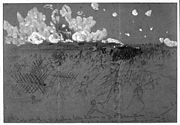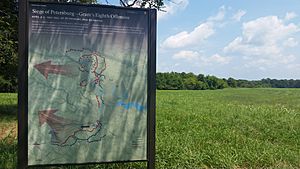Third Battle of Petersburg facts for kids
Quick facts for kids Third Battle of Petersburg(Breakthrough at Petersburg) |
|||||||
|---|---|---|---|---|---|---|---|
| Part of the American Civil War | |||||||
 The battle of Petersburg Va. April 2nd 1865, lithograph by Currier and Ives |
|||||||
|
|||||||
| Belligerents | |||||||
| Commanders and leaders | |||||||
| Ulysses S. Grant George Meade Edward Ord Thomas M. Harris |
Robert E. Lee A. P. Hill † |
||||||
| Strength | |||||||
| 114,335 ∼ 63,000 (engaged) |
40–45,000 18–20,000 (engaged) |
||||||
| Casualties and losses | |||||||
| 3,936 | 5,000 | ||||||
The Third Battle of Petersburg, also known as the Breakthrough at Petersburg, was a major battle in the American Civil War. It took place on April 2, 1865, near Petersburg, Virginia. This battle was a key part of the Siege of Petersburg, which had lasted for 292 days. It also marked the start of the Appomattox Campaign, which led to the end of the war.
The Union Army, led by Lieutenant General Ulysses S. Grant, attacked the Confederate defenses. These defenses were held by General Robert E. Lee's Confederate troops. The Union forces had just won the Battle of Five Forks the day before, which weakened the Confederate lines.
The Confederate defenses around Petersburg were very thin. They had been stretched too far by earlier Union movements. Many Confederate soldiers had also left or were lost in recent battles. Even so, the Confederate defenders fought hard. They held off the Union attack long enough for their government officials and most of the remaining army to escape Petersburg and the capital city of Richmond. During the fighting, Confederate General A. P. Hill was killed.
On April 3, 1865, Union soldiers took control of Richmond and Petersburg. Most of the Union Army then chased Lee's Army of Northern Virginia. Lee was forced to surrender his army on April 9, 1865, after the Battle of Appomattox Court House.
Contents
Background to the Battle
The Long Siege of Petersburg
The Siege of Petersburg began in June 1864. Union forces tried to capture Petersburg, a vital railroad and supply center for the Confederate capital of Richmond. They failed to take the city quickly. So, General Grant began a long period of trench warfare. The Union Army tried to wear down the smaller Confederate Army. They aimed to cut off supplies and stretch the Confederate defenses until they broke.
For over nine months, the Confederates defended Petersburg and Richmond. They used strong trenches and fortifications. But by February 1865, their lines were stretched very thin. General Lee knew his army could not hold on much longer. He hoped to move his army out of Petersburg and join forces with General Joseph E. Johnston in North Carolina.
Attack on Fort Stedman
To try and shorten his lines, General Lee approved a plan by Major General John Brown Gordon. Gordon planned a surprise attack on Union Fort Stedman on March 25, 1865. The attack captured the fort at first. But Union forces quickly counterattacked. They recaptured the fort and pushed the Confederates back. The Confederates lost about 4,000 soldiers, which they could not afford.
After this defeat, Lee knew that Grant would soon attack his remaining supply lines. These were the South Side Railroad and the Boydton Plank Road.
Starting the Appomattox Campaign
Grant's Plan for Attack
Even before the Fort Stedman attack, General Grant had planned a major offensive for March 29, 1865. His goal was to force the Confederates into an open battle. If that didn't happen, he wanted to cut their remaining supply routes to Petersburg and Richmond. The attack on Fort Stedman did not change Grant's plans.
Grant moved many of his troops to the western end of the Petersburg line. This included two infantry corps and Philip Sheridan's cavalry. Their mission was to move west and cut off the Confederate supply lines.
Lee's Response
General Lee knew Grant was planning a move. On March 29, 1865, he sent about 10,600 soldiers, cavalry, and artillery under Major General George Pickett. This force was sent to protect a key road junction called Five Forks. This junction was vital because it controlled access to the last open Confederate roads and railroads.
Early Union Moves
On March 29, Union troops began moving west. Sheridan's cavalry headed towards Dinwiddie Court House. Union infantry corps also moved to extend the Union line.
Battle of Lewis's Farm
On March 29, Union troops met Confederate forces at Lewis Farm. A tough fight followed, with both sides suffering similar losses. The Union forces pushed the Confederates back to their White Oak Road Line. By the end of the day, Union forces had cut the Boydton Plank Road in two places. They were now in a strong position to attack the Confederate right side and the important Five Forks junction.
Battle of White Oak Road
On March 31, Confederate forces attacked an exposed part of the Union line at White Oak Road. The Union troops were pushed back at first. But they quickly regrouped and counterattacked. They drove the Confederates back to their main White Oak Road Line. This battle cut off direct communication between some Confederate forces.
Battle of Dinwiddie Court House
On March 29, Union cavalry under Major General Philip Sheridan took Dinwiddie Court House without a fight. Sheridan planned to take Five Forks the next day. Confederate forces, including cavalry under Major General Fitzhugh Lee and infantry under Major General George Pickett, arrived at Five Forks to defend it.
On March 31, in heavy rain, Confederate forces attacked Sheridan's cavalry near Dinwiddie Court House. The Union cavalry fought delaying actions, slowly falling back. By nightfall, the Union forces had set up a strong defensive line. The Confederates planned to attack again in the morning.
Battle of Five Forks
The decisive Battle of Five Forks was fought on April 1, 1865. It took place at the Five Forks crossroads, which was critical for Confederate supply lines. Union forces under Major General Philip Sheridan, with infantry from Major General Gouverneur K. Warren's corps, defeated the Confederates. The Union Army captured over 2,400 prisoners and took control of Five Forks. This gave them control of the vital South Side Railroad.
General Lee had ordered Pickett to hold Five Forks "at all hazards." However, Pickett and Fitzhugh Lee were away from the battlefield during the main Union attack. The Union infantry attacked the Confederate left flank. The Confederates were quickly overwhelmed and their lines collapsed. This victory was a huge blow to the Confederates.
The Main Battle: April 2, 1865
Lee Prepares to Withdraw
On April 1, after the defeat at Five Forks, General Robert E. Lee realized the situation was dire. He sent a letter to Confederate President Jefferson Davis, saying that he might have to abandon Richmond and Petersburg. He ordered troops from Richmond to reinforce Petersburg. Lieutenant General A. P. Hill also returned to duty to help organize defenses.
Grant Orders a General Assault
When General Grant heard about the victory at Five Forks, he ordered a full assault along the Petersburg lines. He wanted to prevent the Confederates from escaping. Union artillery began a heavy bombardment at 10:00 p.m. on April 1, lasting until 2:00 a.m. The main Union assault began around 4:30 a.m. on April 2.
Sixth Corps Breakthrough
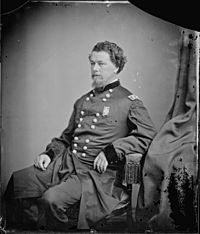
Major General Horatio Wright's VI Corps led a powerful attack. They had carefully planned their assault. The land between the armies was clear, and the Union forces were close to the main Confederate line. The VI Corps had about 14,000 troops attacking only 2,800 defenders.
The Union soldiers were nervous but determined. Many wrote their names on paper and pinned them to their shirts. They feared the attack would be a disaster like previous battles.
The attack began in the dark at 4:40 a.m. Union pioneers cleared obstacles. Despite heavy Confederate fire, the Union troops pushed forward. They quickly overwhelmed the Confederate picket line. The first Union soldiers broke through the main Confederate defenses. Captain Charles Gilbert Gould of the 5th Vermont Infantry was one of the first to enter the Confederate works. He later received the Medal of Honor for his bravery.
The VI Corps surged forward, breaking the Confederate lines. Within about 30 minutes, they had made a decisive breakthrough. Some Union soldiers even reached the South Side Railroad, cutting telegraph lines and damaging the tracks.
The Death of A.P. Hill
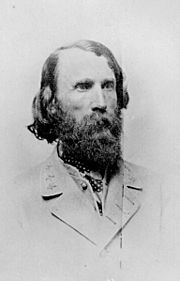
After the breakthrough, Lieutenant General A. P. Hill rode to organize the defense. As he rode through the woods, he encountered two Union stragglers. Hill demanded their surrender, but the Union soldiers fired, killing him. Hill's death was a major loss for the Confederates.
Union Forces Advance on Petersburg
After the breakthrough, Wright's VI Corps reorganized. They turned to attack the remaining Confederate forces to the southwest. They captured Fort Davis, but the Confederates briefly recaptured it. The Union forces attacked again, sweeping the Confederates from their defenses.
By 9:00 a.m., Wright's corps had achieved its objectives. Major General Edward Ord's XXIV Corps joined Wright's forces. They decided to combine their forces and advance toward Petersburg. By 10:00 a.m., 15,000 Union soldiers were moving toward the city's western defenses.
The Fight for Forts Gregg and Whitworth
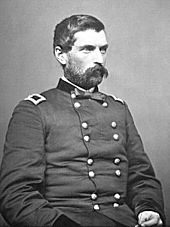
As Union forces advanced, Confederate survivors gathered at Fort Gregg and Fort Whitworth. These forts were part of an older defense line. About 350 Confederates held Fort Gregg, and 200 held Fort Whitworth. Their mission was to buy time for more Confederate reinforcements to arrive at the main Dimmock Line.
Union forces, totaling about 4,000 men, attacked Fort Gregg. The fort was surrounded by a ditch, partly filled with water and mud. Attackers faced deadly fire as they tried to cross the field and get into the ditch. Many soldiers got stuck in the mud. The Confederates threw dirt, stones, and even artillery shells at the attackers.
The battle for Fort Gregg was fierce, lasting about two hours. Union soldiers struggled to climb the walls. Eventually, they found an unfinished trench at the back of the fort. This allowed them to climb onto the walls. After desperate hand-to-hand combat, the Union soldiers finally captured the fort. The interior of the fort was a scene of terrible fighting.
Fort Whitworth fell soon after Fort Gregg. The Confederates defending it were ordered to retreat. The defense of these forts bought valuable time for Confederate reinforcements to reach the Dimmock Line.
Lee Orders Evacuation
When General Lee learned of the VI Corps breakthrough, he sent a message to President Davis. He informed Davis that he would have to abandon Richmond and Petersburg that night. Davis immediately began preparing to move the Confederate government and its important records.
Parke Attacks Southeast of Petersburg
While the VI Corps attacked to the west, Major General John Parke's IX Corps attacked Confederate lines southeast of Petersburg. These lines were very strong, especially around Fort Mahone. The Confederates here were lightly manned, with only about 5,500 soldiers defending over six miles of line.
Parke's attack began around 4:00 a.m. His troops faced heavy fire and strong defenses. They captured several batteries and trenches, including Fort Mahone. However, the attack soon slowed down. The Confederates launched fierce counterattacks, leading to bitter fighting. Soldiers from both sides fought hand-to-hand.
The fighting continued all afternoon. The Union forces lost 1,500 men in these assaults. By evening, both armies held parts of the Confederate works. General Gordon, the Confederate commander, was told that the army would evacuate Petersburg that night.
White Oak Road and Hatcher's Run Line
Major General Andrew A. Humphreys's II Corps faced Confederate forces along the White Oak Road and Hatcher's Run line. After the VI Corps breakthrough, Humphreys ordered his divisions to attack. They captured Confederate redoubts and artillery. By 8:30 a.m., the II Corps held a long section of the Confederate works.
Humphreys then ordered his troops to pursue the retreating Confederates toward Sutherland's Station. Here, Major General Nelson A. Miles's division engaged Confederate forces under Brigadier General John Rogers Cooke. Cooke's men were protecting supply trains. Miles's troops, though tired, fought hard. After several attempts, Miles finally broke the Confederate line. They captured 600 prisoners and two guns.
The South Side Railroad, the last supply line to Petersburg, was now permanently cut. Most of Miles's men were too exhausted to chase the fleeing Confederates.
Casualties
The Union Army lost 3,936 soldiers on April 2, 1865. Confederate casualties were at least 5,000, with most being taken prisoner. Union soldiers were shocked to find very young boys and old men among the dead Confederate defenders. This showed how desperate the Confederacy was for soldiers.
Aftermath of the Battle
The Union victory on April 2, 1865, was a huge turning point. The breakthrough cut the South Side Railroad, a vital supply line. It also gave the Union Army access to the Appomattox River, threatening Lee's escape routes.
At 3:00 p.m., General Lee gave the orders for his army to retreat from Richmond and Petersburg. The retreat began at 8:00 p.m. Most of the army moved west, aiming for Amelia Court House. They took about 200 light artillery pieces and over 1,000 wagons with them.
By 11:00 p.m., President Jefferson Davis and his cabinet left Richmond by train. They headed for Danville, Virginia.
General Grant was very pleased with the victory. He wrote to his wife, saying it was "one of the greatest victories of the war." He ordered a final bombardment and assault for the next morning. However, at 3:00 a.m., Union commanders discovered that Lee had abandoned his defenses.
On April 3, 1865, the Confederate capital of Richmond fell to Union forces, along with Petersburg. General Grant met with President Lincoln in Petersburg. The retreat of Lee's army continued, leading to its surrender at Appomattox Court House on April 9, 1865.
See also
 In Spanish: Tercera batalla de Petersburg para niños
In Spanish: Tercera batalla de Petersburg para niños


